Back in the innocent days of early January, I began a multi-part review of Sam Mustafa’s Longstreet ACW rules, using the fictional battle of MacGillicuddy’s Corners as an example of play. In posts One, Two, and Three, the 90-day volunteers of a US brigade under a German-born colonel, Hienrich Schotz, clashed with a mirror-image brigade of Confederates somewhere in the vast US West. The battle unfolded as a meeting engagement, and was a useful way of teaching myself the Longstreet rules.
To pick things up as the battle reaches a climax, in the bottom centre of the photo, the Schlitz Jaegers stand firm, having lost two of six stands. To their right, MacCleary’s Milwaukee Irish, “The Fightin’ Navvies”, wing around the MacGillicuddy farmhouse, moving to bolster the Kansas Liberty Jayhawkers, dismounted cavalry skirmishing with their opposite numbers, the 3rd Kentucky Rangers, who are quite happy with their position behind a wooden fence. In Longstreet this sort of protection means that attackers have to use Skirmish Fire to target them, making them a much worse target. At the bottom left, the Pabst Blue Rifles are falling back, having been flanked off the hill. In the centre, the 21st Mississippi, with 5 of 6 stands, move forwards, while behind them the 5th Kentucky Lincoln Killers move towards the retreating Pabst Blue Rifles. Just visible on the far left, Snedden’s battery uses its hill to advantage, bombarding the Schlitz Jaegers.
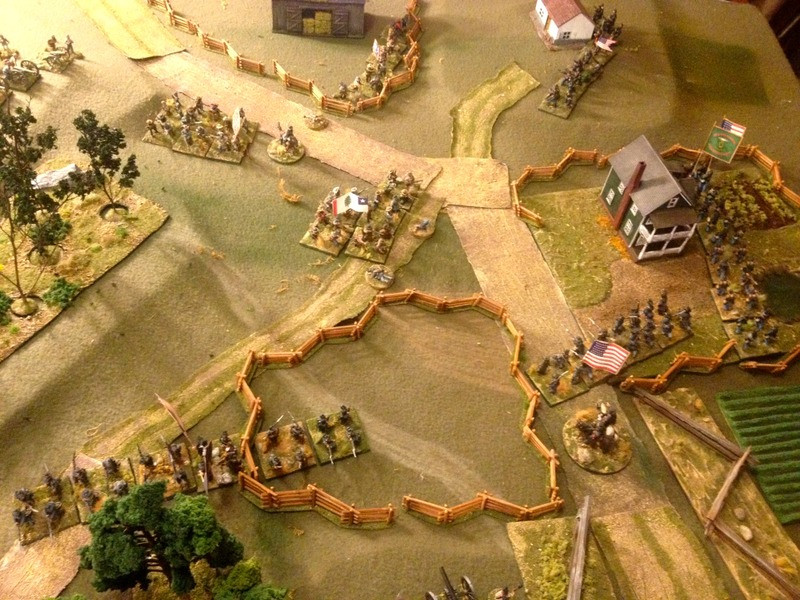
Two of the 6lber guns of Engel’s Brewers Battery bombards the 21st MS. The third gun is screened by the retreating Pabst Blue Rifles. Note my oh so sexy range stick, marked in my standard Base Widths increments. In Mustafa rules, the Base Width is the standard unit of measurement, and depends on whatever base sizes the player is using. At 9 BWs, the target is 3BWs outside of canister range. Sadly no result this time
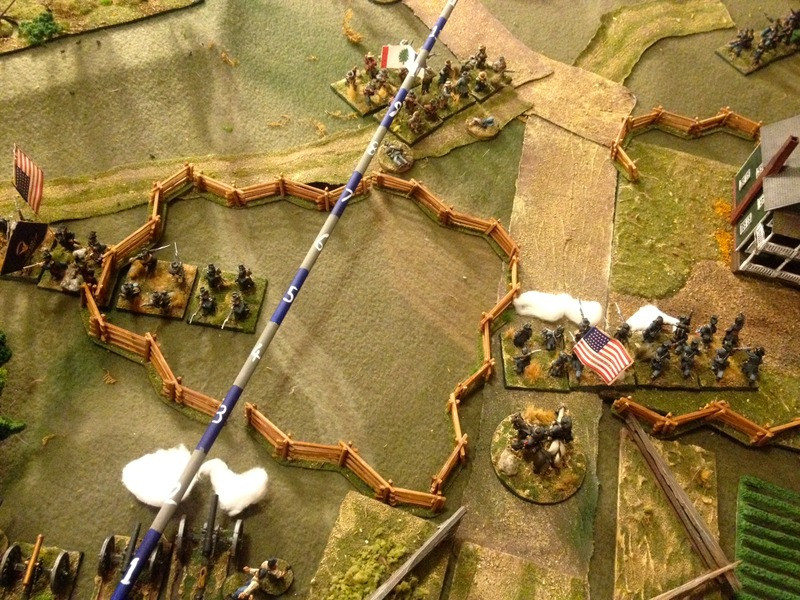
The Kansas cavalry skirmish with their opposite numbers, to no effect, while Major Luigi, who seems to be a Confederate sympathizer, looks on.
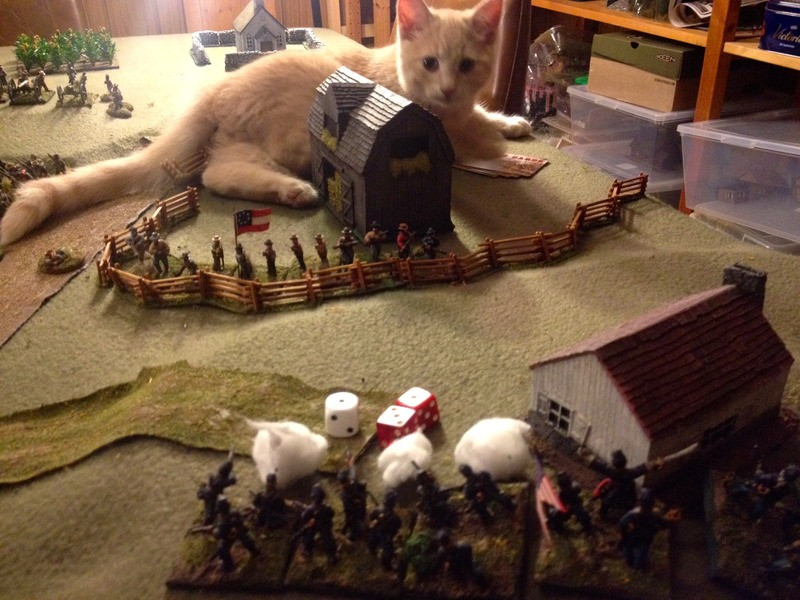
Kentucky troopers return the compliment. The figures closest to the camera are from the Redoubt ACW range, one of my favourite product lines for this period.

The Kansas Jayhawkers lose a stand, while behind them the Irish move forward.
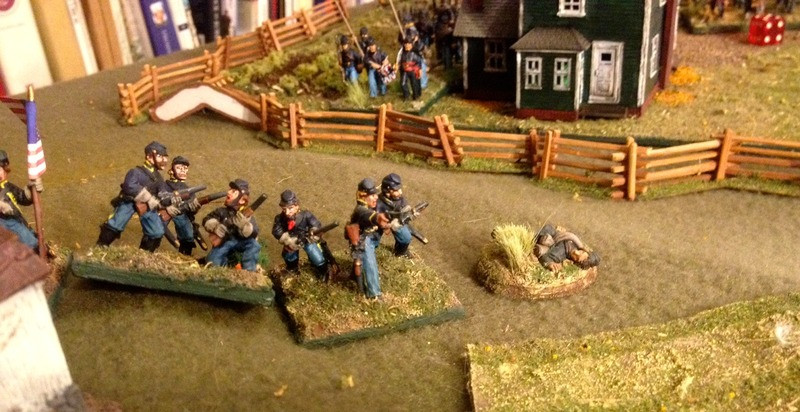
Your range stick is my favourite toy. You can’t have it.
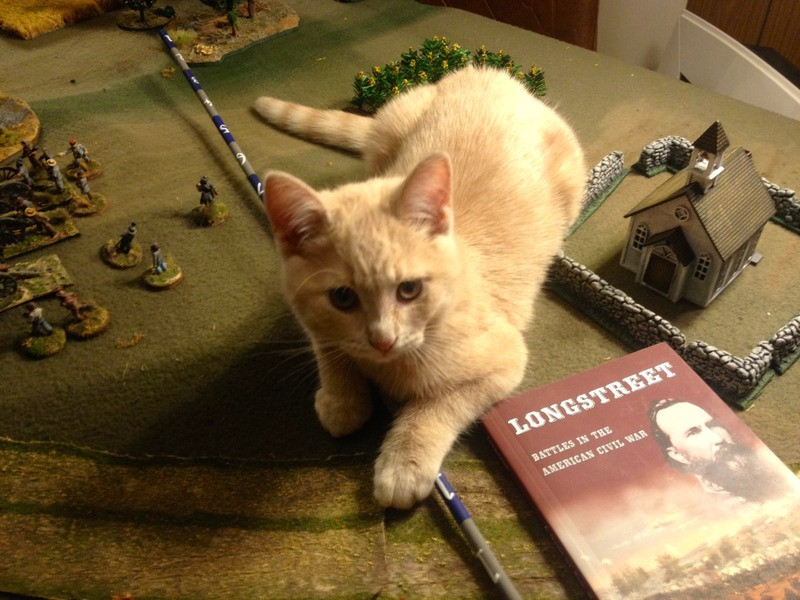
Confederates begin to bring pressure. The 4th Texas, which has spent much of the battle marching and countermarching, and the 5th KY Lincoln Killers begin to converge on the retreating Union infantry. By this point Col. Schotz has realized that the three infantry regiments of his brigade are all too far apart to support one another.
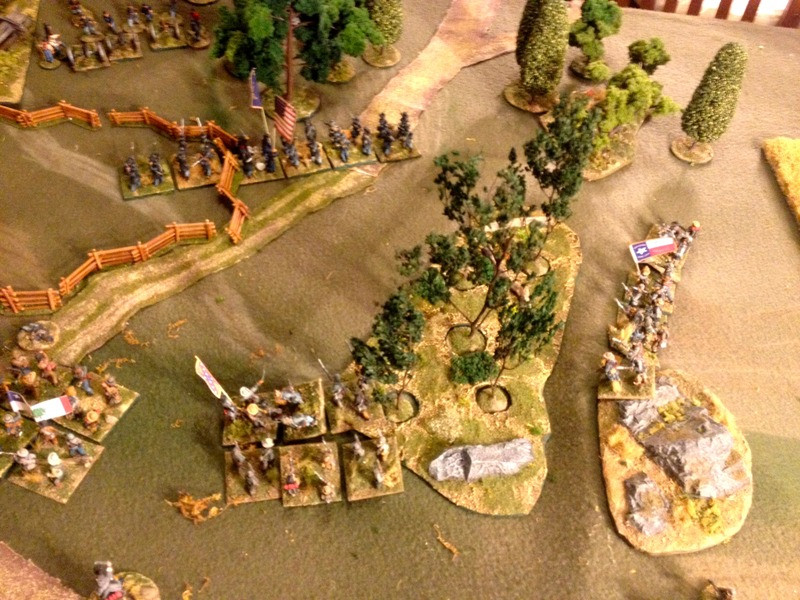
Engel’s battery fires again at the 5th KY. This is a good example of how a fire card in Longstreet can add some punch at a key moment. Having played a card to declare a fire phase, I can play a second card like this one (if I have it in my hand) to modify the fire. Crews in this shot are all Foundry, the guns are a mix of Foundry and Redoubt.
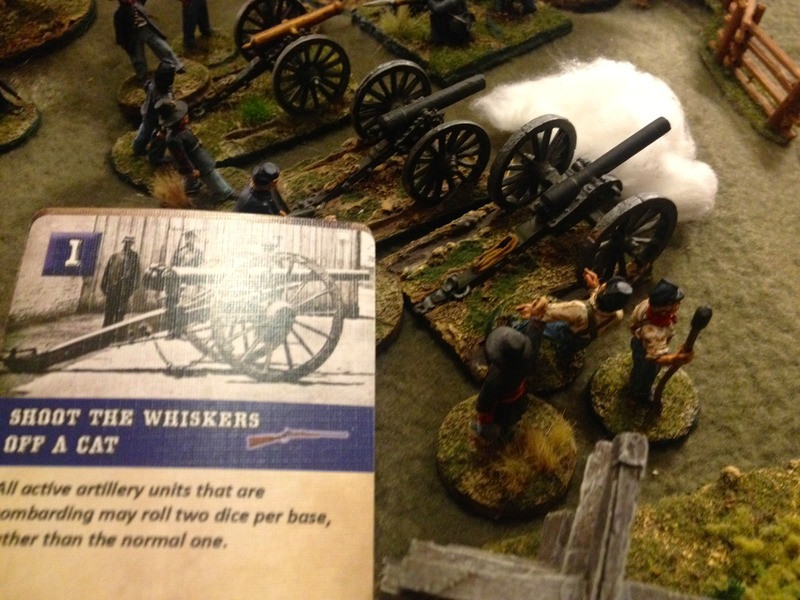
Two hits on the 5th KY, which the CS mitigates to one (one hit always sticks in these rules) using a card. Sadly, no damage. Union shooting isn’t that great in this game.
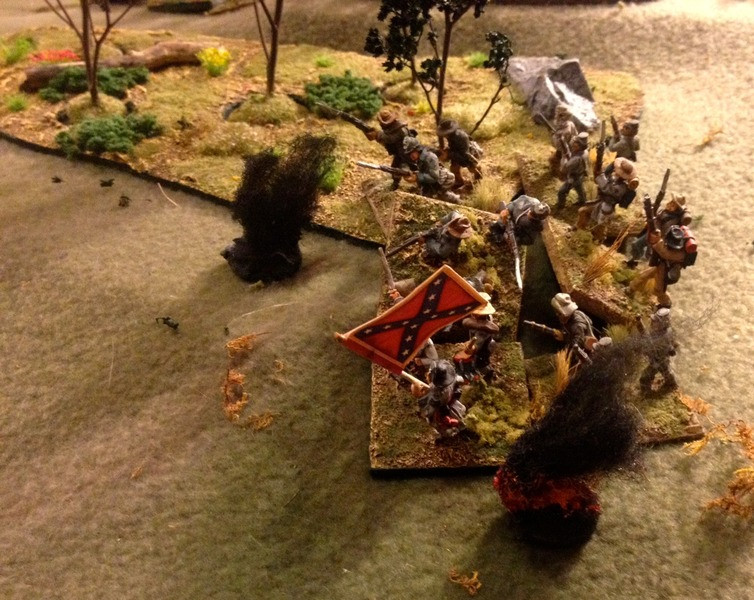
Schlitz Jaegers unleash a volley on the advancing 21st MS. With four stands, they get an impressive four hits, which the CS mitigates to two, using another card. Because all units in the game are Inexperienced, only one card can be played on a unit to mitigate hits. Had the 21st MS been Veteran or better, and had the CS player been willing to burn two cards, the hits could have been reduced to one. As it is, one of the two hits is a kill, knocking the 21st MS to four stands. There are no individual morale checks in Longstreet. If a unit is reduced to one stand, it is removed from the game. If a force loses half of its starting number of bases, it breaks and loses the game. Otherwise play continues.
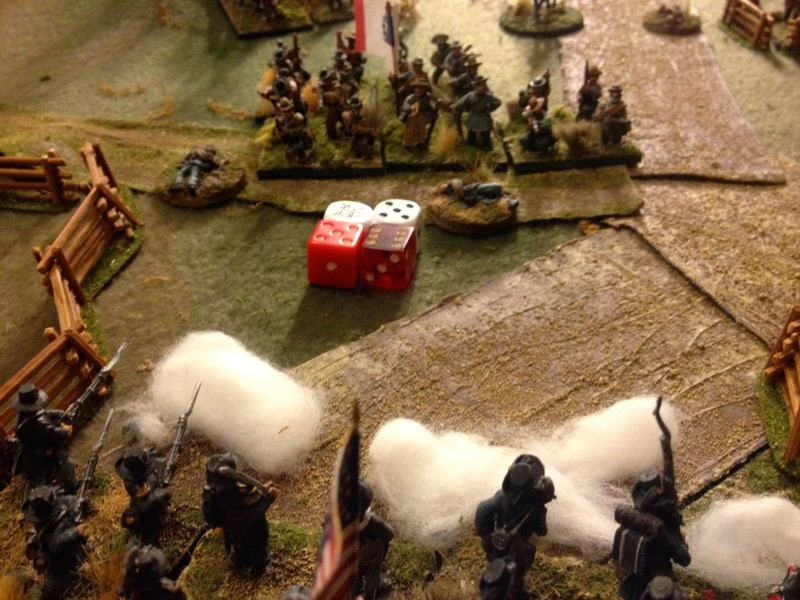
In the next turn, the CS player (me, I guess, but I like referring to myself in the third person) elects on a Combat round instead of a Movement round. During a combat round, any unit within 6BWs of an enemy may charge into melee - sometimes the distance can be more than 6BWs if the right card allows for it. Units which are not within range do not get to Move that round - the choice is either Combat or Movement, so this forces a player to manoeuvre as many units as possible into charge range to maximize the effect. Combat is a fairly simply business - the defender gets a dice per base, the attacker gets a dice per base of the first two ranks charging into combat. One unit may split its dice against several defending units, or vice versa. The Attacker usually gets a slightly better chance of inflicting casualties depending on circumstances such as modifying cards and terrain. In this case the unlucky Schlitz Jaegers lose two stands and fall back.
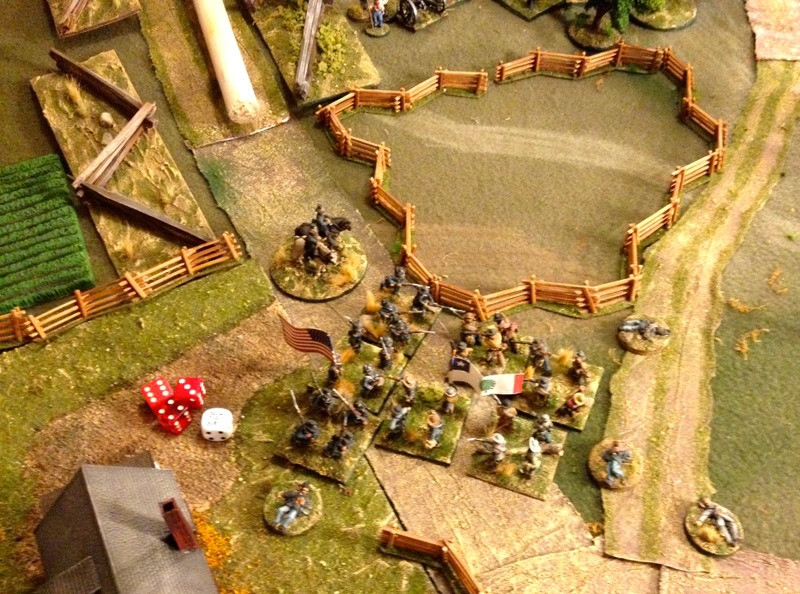
MacCleary’s Irish spend the next turn charging the rebel cavalry behind their fence. Ideally the Union cavalry should have charged as well, making it two attackers on one defender, but I had elected to move them laterally to give the infantry space to charge, which was a mistake. The rebels rolled well and held firm. The Irish were thrown back and lost a stand.
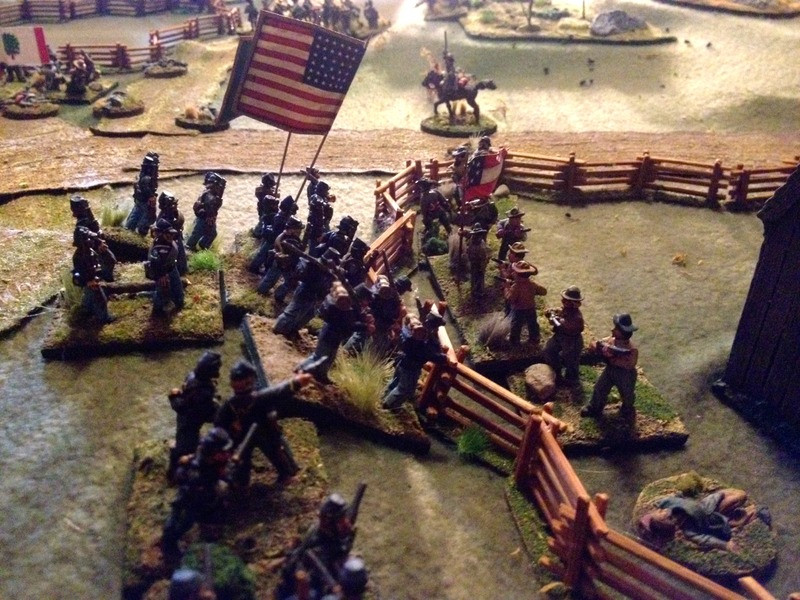
At this point I wasn’t taking pictures of every single action. The 5th KY closed on Engel’s battery, which got one turn to fire canister with two of their three guns, throwing a handsome four dice for hits, which, sadly, all missed. Meanwhile the Pabst Blue Rifles had turned about to face the 4th TX, but didn’t get a shot at them because they were screened by the woods. Both rebel regiments charged together, throwing an incredible eleven stands into battle. In Longstreet, there is a chrome rule called Epic Points, which basically give players bragging rights for actions that are within the code of honour and glory that made the Civil War so charming and so deadly. The CS player would have automatically gotten an Epic Point for a Combat Phase involving ten or more stands. While the Pabst Blue Rifles held firm and tied the Texans, so no retreats or casualties on either side, Engel’s battery lost a gun and the surviving two limbered and withdrew, forcing them off the table. Because the infantry combat was a tie, the Texans fell back.

Pabst Blue Rifles hold firm against the charging 4th Texas. Such a cool shot. Union figures are Redoubt and Foundry, Confederate figures are Old Glory and Foundry.
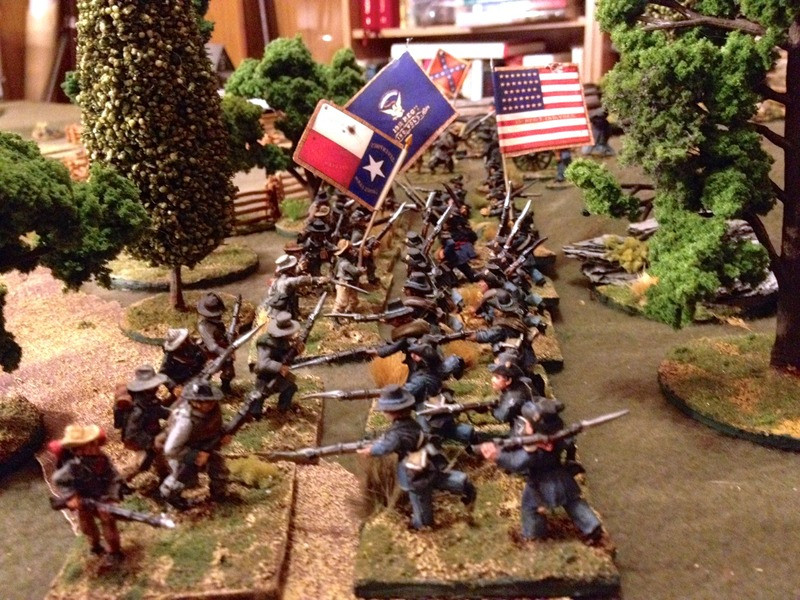
By this point, the poor Schlitz Jaegers had lost another stand from infantry fire and had been dissolved, so with all the Union units bloodied, I decided that Col. Schotz would withdraw and try his luck another day. The CSA were left in possession of the crossroads, and Col. Crutch would be a rising star in the Confederacy. Here confederate troops make a melancholy tour of the battlefield. The casualty figures are by Redoubt, I put one down wherever a base was lost, until I ran out! It provides an effective if somewhat macabre way of tracking the battle.
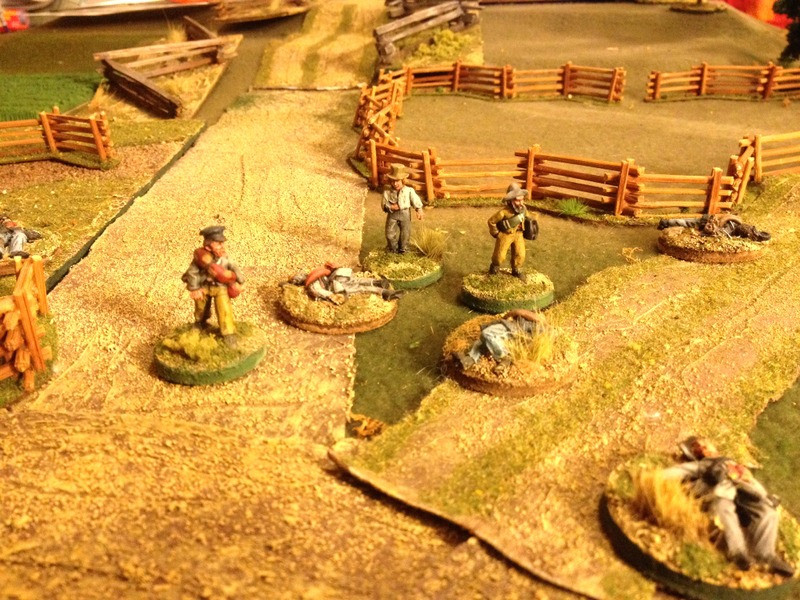
Both sides suffered somewhat from the attentions of Luigi - including some banners that now have realistic battle damage from tiny kitten teeth.
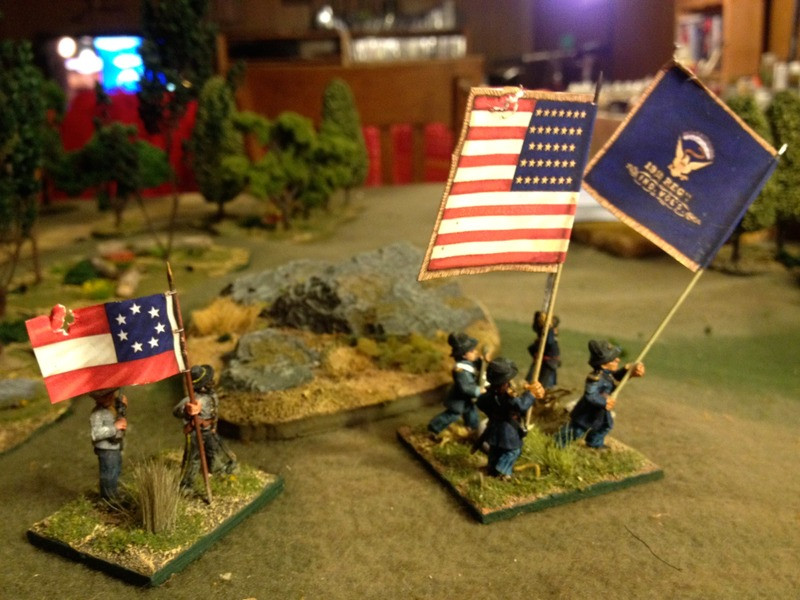
For the Campaign Game, Longstreet has a very interesting post-battle mechanism. Poor Col. Schotz didn’t earn enough Epic Points to get promoted (he only got two for showing up), so he will soldier on as commander of a somewhat reduced brigade. 1 in 3 of bases lost in the game are permanently lost, and units take additional losses from attrition and camp sickness after every game. Even after getting some reinforcements, Schotz’s brigade now has the following strength:
Schlitz Jaegers: 2 stands (still classed as Green but have lost their Eager status, so are considerably less useful)
Pabst Blue Rifles: 5 stands, and gained Veteran Status. Same with MacCleary’s Irish. Both units retained their Eager rating, so are still rated as aggressive.
Kansas Jayhawker cavary: 4 stands.
Engel’s battery: two stands of guns, one a howitzer, one a 6lber smoothbore.
When they take the field again in 1862, I suspect that Schotz’ brigade will be paired with another Union brigade in their next battle. They will also lose their colourful names, and be remustered into state service as three year regiments. It will be a long war.
Bottom line, I quite like these rules and recommend them highly. If I wanted a faster moving game for a larger scale battle, I would likely choose the TFL rules set, They COuldn’t Hit an Elephant, but Longstreet definitelyhas merit as a playable and fairly realistic model of Civil War combat.
Blessings to your die rolls!
Michael

Caesar used to refer to himself in the 3rd person so you are in good company.
ReplyDeleteThanks for a good report, useful and entertaining with such pretty pictures. (Ok pretty might not be the right technical term).
Nice one Mike. Did a volley indeed, shoot the whiskers off a cat?
ReplyDeleteExcellent report, Mike. I will play Longstreet...as soon as I find time to paint some figures. Which will be any soon. On a geological timeline...
ReplyDeleteGood looking game. I like the idea of making a stand loss with a casualty figure.
ReplyDelete